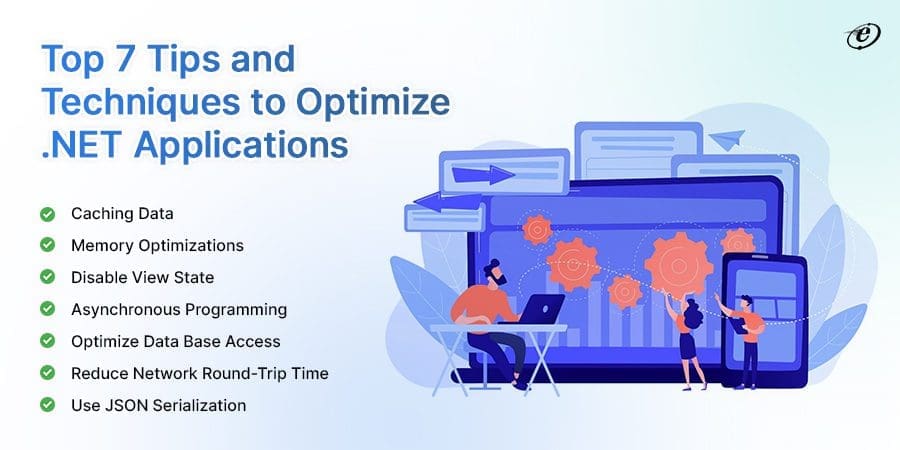
Optimizing Performance in .NET Web Applications: Tips and Techniques
The driving force of everything in today’s digital world is speed. If a website takes a lengthy time to load, it won’t matter how complex or beautiful it is. Performance should be your first focus when designing an application or website.
The best eCommerce site in the world, Amazon, tried experimenting by slowing the sites down by 100ms and noticed the sales decreased by 1%.
In addition, a survey revealed that 40% of visitors abandon a website if it takes more than three seconds to load.
From these examples, we are sure you got the idea of how crucial the performance of an application is.
Today, we’ll discuss useful tips and techniques for performance improvement during .NET application development.
Microsoft created the software development framework “.NET.” It offers a platform for creating and running apps across several platforms and programming languages. It is essential to optimize .NET applications to increase their performance, scalability, and maintainability.
Although .NET enterprise applications show performance, it doesn’t imply there isn’t potential for improvement. Any application’s performance and speed can constantly be improved with a few minor adjustments, and these modifications can produce some amazing outcomes.

With increasing competition (around 3,217,982 websites using .NET technology), users now expect unique, faster, and reliable solutions. So, as a top provider of.NET application development services, what would you do? Would you like to hire .NET developers or merely look for methods to improve the speed of your web application?
This article covers tried and tested tricks and tools to make your.NET code more efficient, increase application performance, and guarantee a positive user experience.
Let’s dive deeper into all of them!
Top 7 Tips to Optimize .NET Application Development Processes.
Must implement the below-given tricks and useful techniques and see the result by yourself

1. Caching Data
The amount of time a website takes to load rises if it is hosted on a single server. The same server must handle requests from every user, which takes time. The website is under significant strain of visitors, which makes it take longer for pages to load.
Catching your data is the answer to this problem.
Caching is a technique used in software development to store data that is computationally expensive or frequently accessed temporarily. The Cache functions as a fast-access memory between the data source and the application.
How does it work?
The server is called, and the reply obtained is saved. As a result, the next time a request is made for a similar response, instead of going to the server, the data is verified against the cached data, and if they match, the stored data is obtained.
Depending on the type of content, the memory can either hold the complete page or just a portion of it. Professional .NET application development services providers are required to customize the output cache for dynamic content pages so that the appropriate content will be displayed based on the input.
How should I utilize the Cache?
- The Cache should be used throughout all DataAccess, UILayer, and business layers.
- Utilize Cache to cache the page component partially.
- Avoid caching costly objects in Cache, such as connections.
- For static pages, use output caching and place it where needed.
Types of Caching Techniques
Different kinds of caching strategies can be utilized in .NET application development. You can select the ideal caching strategy to maximize speed and enhance the user experience depending on the specific requirements and .NET application architecture. Here are three typical categories and some coding examples for each:
1.1 Memory Caching
Data is saved in the application’s memory for quick retrieval using the technique known as in-memory caching. It makes it possible to serve subsequent requests directly from the cache, avoiding the need to access the original data source. Here is an illustration of in-memory caching using the.NET MemoryCache class.
using System.Runtime.Caching;
MemoryCache cache = MemoryCache.Default;
string cacheKey = "myCachedData";
if (cache.Contains(cacheKey))
{
var cachedData = (string)cache.Get(cacheKey);
DoSomethingWithCachedData(cachedData);
}
else
{
var data = GetDataFromDatabase();
cache.Add(cacheKey, data, new CacheItemPolicy { SlidingExpiration = TimeSpan.FromMinutes(10) });
DoSomethingWithCachedData(data);
}:
1.2 Distributed Caching
Distributed caching using Redis Cache involves using the Redis database as a caching solution that can be accessed by multiple servers or instances of an application. Redis, an in-memory data structure store, provides high performance and scalability. Here are some easy steps for using Redis Cache for distributed caching in a .NET application development.
Here are some easy steps
- Install the StackExchange.Redis NuGet package in your project.
- Initialize the Redis cache connection:
using StackExchange.Redis;
// Create a ConnectionMultiplexer to connect to the Redis cache server ConnectionMultiplexer redisConnection = ConnectionMultiplexer.Connect("your-redis-server:6379");
// Get a reference to the Redis cache database
IDatabase cacheDb = redisConnection.GetDatabase();
-
-
- Store and retrieve data from the cache:
-
// Store data in the cache
string key = "myKey";
string value = "Cached Value";
cacheDb.StringSet(key, value);
// Retrieve data from the cache
string cachedValue = cacheDb.StringGet(key);
-
-
- Set an expiration time for the cached data:
-
// Store data in the cache with an expiration time of 30 minutes
TimeSpan expirationTime = TimeSpan.FromMinutes(30);
cacheDb.StringSet(key, value, expirationTime);
-
-
- Remove data from the cache:
-
// Remove data from the cache
cacheDb.KeyDelete(key);
1.3 Output Caching
This type of caching technique is mainly used in .NET application development. Cache the rendered output of a web page or a particular action method. It enables subsequent requests for the same page or action to be directly provided from Cache without running the relevant server-side code. Let’s have a look at the example below of output caching.
public class HomeController : Controller
{
// Enable output caching for the Index action method
[OutputCache(Duration = 3600)] // Cache the output for 1 hour
public ActionResult Index()
{
// Logic to generate dynamic content
string dynamicContent = GenerateDynamicContent();
return View(dynamicContent);
}
}
2. Memory optimizations
It’s an exhaustive resource for your application that is directly related to how well it works. Poor resource management will reduce the performance by placing stress on your CPU.
In .NET application development, memory optimization is an essential factor to consider. Object pooling, reducing the object’s size, and preventing memory leaks are all ways that developers can increase the scalability of their applications and lessen memory-related problems. Let’s look more closely at each of these methods.
2.1 Eliminate Memory Leak
Memory leaks can occur in .NET applications when objects are not properly disposed of, causing them to remain in memory indefinitely. Common causes include improper handling of unmanaged resources, circular references, event handler subscriptions not being removed, and static objects not being released.
To avoid memory leaks in .NET applications, follow these best practices:
| Properly Release Unmanaged Resources | Ensure that objects implementing the IDisposable interface are disposed of correctly using the using statement or by manually calling the Dispose() method to release unmanaged resources. |
| Dispose Event Handlers | Remember to unsubscribe and remove event handlers when subscribing to events when they are no longer needed. Failing to do so can prevent objects from being garbage collected. |
| Avoid Unnecessary Object Retention | Make sure objects are released when they are no longer needed. Remove unnecessary references to objects, making them eligible for garbage collection. |
| Use Memory-Profiling Tools | Employ memory-profiling tools like dotMemory or Visual Studio Memory Profiler to identify memory leaks and analyze object retention patterns in your application. |
| Be Cautious with Static Objects | Be mindful when using static objects, as they can persist in memory throughout the application’s lifetime. Ensure that static objects are cleaned up properly, or consider using weak references. |
| Avoid Circular References | Be cautious when creating circular references between objects, as they can prevent objects from being garbage collected. Use weak references or break the circular references when necessary |
| Test with Large Datasets | Test your application with large datasets or stress-testing scenarios to identify potential memory leaks under heavy load or extended usage. |
Along with following these practices, regularly review and analyze your codebase for potential memory leak sources. Conduct code reviews and perform memory profiling to identify and address any memory leak vulnerabilities.
2.2 Object Pooling
Implementing object pooling allows you to reuse existing objects rather than create new ones, which reduces memory requirements and boosts the productivity and effectiveness of .NET application development. By doing this, memory allocation and trash collection overhead can be decreased.
For object pooling in C#, use the ObjectPoolT>class.
public class ObjectPool<T> where T : new()
{
private readonly Queue<T> objectQueue;
public ObjectPool()
{
objectQueue = new Queue<T> ();
}
public T GetObject()
{
lock (objectQueue)
{
if (objectQueue.Count > 0)
{
return objectQueue.Dequeue();
}
}
// If the pool is empty, create a new object
return new T();
}
public void ReturnObject(T obj)
{
lock (objectQueue)
{
objectQueue.Enqueue(obj);
}
In this example, we define a generic ObjectPool<T> class that can be used for pooling any object. The object pool is implemented using a Queue<T> to store and manage the objects.
To use the object pool, you can create an instance of ObjectPool<T> and retrieve objects using the GetObject() method. If available objects are in the pool, it returns one; otherwise, a new object is created.
After using the object, you can return it to the pool using the ReturnObject() method. The returned object is then added back to the pool for reuse.
2.3 Reducing Object Size
Reducing the memory footprint of objects in your .NET application development leads to improved performance, reduced memory usage, and efficient resource utilization.
Follow the below-given tips to reduce object size in .NET application development.
-
- Replace reference types with value types (structs) when possible, as they are stored on the stack and have a smaller memory footprint.
- Minimize the number of fields in objects, especially large reference types, to reduce their overall size.
- Use StringBuilder for string concatenation instead of multiple string concatenations and internal strings to reduce memory consumption.
-
- Utilize compression algorithms (e.g., GZIP) to reduce the size of serialized or stored objects.
- Reduce the amount of data stored or transmitted by truncating or aggregating values when precision or granularity is not critical.
- Choose the most appropriate collection type based on the specific requirements to minimize memory overhead.
- Choose compact serialization formats like Protocol Buffers or MessagePack to reduce object size during serialization and deserialization.
- Use memory profiling tools to identify memory-hungry objects, analyze their size and references, and optimize accordingly to reduce memory footprint.
3. Disable View State
Disabling View State is another tried-and-true method a seasoned .NET development company uses to enhance .NET application performance. The View State method is a state management technique used by .NET to maintain page and control data over round trips.
The .Net page framework employs View State as a technique to maintain page and control values throughout postbacks. The.Net pages are sent to the server for processing via postbacks. The view state hidden fields store the serialized, encoded strings that represent the values of the page that need to be preserved.
The view state field is no longer necessary in many circumstances, such as when the control only changes as a result of user activities or when it is automatically filled after each postback. You would therefore be better off disabling this function in such circumstances. Due to the serialized (and de-serialized) data and the additional memory allocations on the server, the view state increases the load on the page. All of this causes the page to load much more slowly.
In such situations, it’s better to disable the view state. Let’s see how to do that.
To disable the view state in a .NET application, you can set the EnableViewState property to false for the relevant controls or for the entire page. Here’s a coding example:
<%@ Page Language="C#" EnableViewState="false" %>
<!DOCTYPE html>
<html>
<head>
<title>Disable ViewState Example</title>
</head>
<body>
<form id="form1" runat="server">
<asp:TextBox ID="txtName" runat="server" EnableViewState="false"></asp:TextBox>
<asp:Button ID="btnSubmit" runat="server" Text="Submit" OnClick="btnSubmit_Click" EnableViewState="false" />
</form>
</body>
In this example, the EnableViewState= “false” attribute is set for both the TextBox control (txtName) and the Button control (btnSubmit), disabling the view state for these specific controls.
At the page level, the EnableViewState= “false” attribute is also set in the @Page directive, which disables the view state for the entire page.
By disabling view state, you can reduce the overhead of storing and transmitting view state data, improving performance and reducing page size.
4. Asynchronous programming
A blocking call delays the completion of the subsequent execution. Hence try to stay away from writing blocking calls during .NET application development.
Blocking calls or synchronous calls can be anything, whether you’re retrieving data from an API or carrying out internal tasks. Always carry out the call in an asynchronous manner.
Asynchronous programming enables you to run numerous processes simultaneously without stopping the main thread, which helps dedicated .NET developers to create responsive and scalable apps.
In C# 5.0, the asynchronous programming approach was introduced and quickly gained popularity. The same asynchronous programming approach is used by .NET application development services providers to increase an application’s reliability, speed, and responsiveness.
The below illustrations highlight various situations in which asynchronous programming can be used in .NET applications.
-
Asynchronous Method with async/await
public async Task<string> DownloadDataAsync(string url)
{
HttpClient client = new HttpClient();
string data = await client.GetStringAsync(url);
return data;
}
In this example, the DownloadDataAsync method uses the async keyword and await operator to perform an asynchronous HTTP GET request using HttpClient. The method returns a Task<string> and asynchronously retrieves the data from the specified URL.
-
Asynchronous Event Handling
public async Task HandleButtonAsync(object sender, EventArgs e)
{
await Task.Delay(1000); // Simulate asynchronous operation
Button button = (Button)sender;
button.Text = "Clicked!";
}
Here, the HandleButtonAsync method is an event handler for a button click event. It uses async/await and the Task.Delay method to introduce an artificial delay. The method updates the button’s text asynchronously after the delay.
-
Parallel Processing with Parallel.ForEach
public async Task ProcessDataAsync(List<int> data)
{
await Task.Run(() =>
{
Parallel.ForEach(data, async item =>
{
await ProcessItemAsync(item);
});
});
}
public async Task ProcessItemAsync(int item)
{
// Asynchronous processing logic for each item
In this example, the ProcessDataAsync method processes a list of data items in parallel using Parallel.ForEach. Within the loop, the ProcessItemAsync method is called asynchronously for each item.
These examples showcase different scenarios where asynchronous programming can be applied in .NET applications. Asynchronous programming allows non-blocking execution, improves responsiveness, and enhances scalability by efficiently utilizing resources.
-
-
-
Asynchronous Querying
Use asynchronous queries to prevent stopping a thread while the database processes the query. For client applications that respond quickly, async queries are essential.
Examples:
-
-
- ToListAsync()
- ToArrayAsync()
- SingleAsync()
<
public async Task<List> GetBlogsAsync() { using (var context = new BloggingContext()) { return await context.Blogs.ToListAsync(); } }-
-
-
Asynchronous Saving
-
-
Asynchronous Saving prevents a thread block while database changes are being made. DbContext is made available.DbContext’s asynchronous replacement is SaveChangesAsync().SaveChanges().
public static async Task AddBlogAsync(string url) { using (var context = new BloggingContext()) { var blogContent = new BlogContent { Url = url }; context.Blogs.Add(blogContent); await context.SaveChangesAsync(); } }5. Optimize database access
If you optimize the data access logic in your .NET application development, you can increase the application’s performance by many folds. As most applications are entirely dependent on databases, we need to regularly retrieve data from databases to display it on user interfaces. If it takes a long time, it will take a long time for the application to load.
WordPress CMS uses a lot of storage to store posts, comments, pages, and other types of text-based and encrypted data. Over time, the database fills up and accumulates useless information like spam queued comments, disapproved comments, post changes, and deleted objects like posts and pages.
Get rid of all this useless information and junk data. Post revisions should be limited, disabled, and removed. Different CMS use various optimization methods like WP-Optimize for WordPress.
As it takes time to fetch the data each time because it comes from the database, the .NET application development can be made faster by optimizing the data access logic.
Here are a few techniques that could be utilized to create code that would significantly improve performance.
- Try retrieving the data in one or two calls to the server rather than several.
- If it is not necessary, do not retrieve the data in advance. The application slows down due to the increased demand for the response.
- Use Entity Framework Core (EF Core) or other Object-Relational Mapping (ORM) technologies to make your database searches more efficient.
- Avoid making repeated database calls by using caching to save frequently accessed data.
- To avoid the expense of several queries for complex activities, think about using stored procedures.
- Set the cache frequently on data that isn’t changing.
6. Reduce Network Round-Trip Time
One of the most effective ways to boost the overall speed of your.NET application is to minimize the number of networks round-trips by compressing data, employing HTTP compression, and lowering the size of payloads. Let’s cover how it will affect your .NET application development.
6.1 Compressing Data
Another strategy that .NET development companies frequently use to reduce file size is “Responsive compression.” Response compression reduces the file size and is a middleware component available in .NET. Responses are typically not natively compressed. Usually, this contains HTML, XML, JavaScript, CSS, and JSON.
When to use Responsive Compression Middleware?
When your application is unable to use the following server-based compression technologies:
Or else when your app is Hosted directly on:
The following code example shows how to enable Response Compression Middleware for the default MIME types and compression providers.
public class Startup { public void ConfigureServices(IServiceCollection services) { services.AddResponseCompression(); } public void Configure(IApplicationBuilder app, IHostingEnvironment env) { app.UseResponseCompression(); } }These types of providers generally used to compress data
- Brotli Compression Provider
- Gzip Compression Provider
- Custom providers
public void ConfigureServices(IServiceCollection services) { services.AddResponseCompression(options => { options.Providers.Add<BrotliCompressionProvider()>; options.Providers.Add<GzipCompressionProvider>(); options.Providers.Add<CustomCompressionProvider>(); options.MimeTypes = ResponseCompressionDefaults.MimeTypes.Concat( new[] { "image/svg+xml" }); }); }Points to be noted
- Never compress assets that were originally compressed, such as PNG files.
- Do not compress files that are less than 150–1000 bytes.
- Use the WP-rocket or W3 Total Cache plugin to enable GZIP compression if your website runs on WordPress.
- The optimum place to enable GZIP compression is on an Apache or Nginx server.
- Images, PDFs, and other binary data shouldn’t be GZipped as these are already compressed.
6.2 Minimize HTTP Requests
When a visitor wants to access a particular element on your website, it takes a long time to render the page and makes additional HTTP requests. One of the key optimizations is lowering the amount of HTTP requests. Reduce the number of connections to the web server by caching the websites and avoiding client-side redirection.
The major techniques to minimize HTTP requests:
Some Tested Tips to Reduce the HTTP Requests
-
- Combine and minify CSS/JavaScript.
- Use CSS sprites for multiple images.
- Enable HTTP compression on the server.
- Implement client-side and server-side caching.
- Utilize content delivery networks (CDNs) for static resources.
- Load data dynamically using AJAX.
-
- Minify your HTML, CSS, and JavaScript files. There are many ways and tools to minify these files, such as JavaScript Minifier, WillPeavy, or Grunt tools.
- Review and remove unnecessary third-party dependencies.
- Enable HTTP/2 for multiplexing requests.
- Use lazy loading or infinite scrolling for data. These techniques reduce round trips, optimize resources, and improve performance in your .NET application.
6.3 Reduce Payload Size
This is an additional technique to reduce network roundtrips. The payload size and number of network roundtrips can be decreased by delivering only the required information. Pagination, lazy loading, and data filtering techniques can accomplish this.
-
-
-
Pagination
Pagination in .NET application development refers to the practice of dividing a large set of data into smaller, manageable subsets or pages. It allows for displaying and navigating through data in a structured manner, typically by using controls or methods to handle the retrieval and presentation of data in chunks.
// Pagination var page = 1; var pageSize = 10; var data = GetLargeDataSet(); var pageData = data.Skip((page - 1) * pageSize).Take(pageSize);-
-
-
Lazy Loading
-
-
Lazy loading in .NET application development is a technique where data or resources are loaded only when they are actually needed, rather than loading everything upfront. It helps improve performance by deferring the loading of non-essential data or heavy resources until they are explicitly requested, reducing initial loading times.
// Lazy Loading var orders = db.Customers.SelectMany(c => c.Orders);-
-
-
Data Filtering
-
-
It is the process of selecting specific data records from a larger dataset based on specified criteria or conditions. It involves applying filters or predicates to the dataset to extract only the relevant data that meet the desired criteria, providing a more targeted and refined subset.
// Data Filtering var filteredData = data.Where(d => d.Category == "Books");7. Use JSON Serialization
‘SystemText’ is used by leading .NET development companies for JSON serialization to and deserialization from options. As a result, JSON can be read and written asynchronously without the need to wait for other processes to finish. Use JSON instead of NEwtonsoft because it enhances performance.
In addition, the System.Text.Json namespace offers conforming, high performance, low allocation, and object to JSON text serialization and deserialization capabilities. The following features are available for processing JSON through the System.Text.Json namespace:
-
-
- High caliber.
- Minimal allotment.
- Capabilities that adhere to standards.
- Deserializing JSON text into objects and serializing objects into JSON text.
-
Here’s an example of using System.Text.Json in a .NET application:
using System; using System.IO; Using System.Txt.Json; using System.Text.Json; namespace JsonExample { class Program { static void Main(string[] args) { // Serialize an object to JSON var person = new Person { Name = "John Doe", Age = 30, Email = johndoe@example.com }; string jsonString = JsonSerializer.Serialize(person); File.WriteAllText("person.json", jsonString); Console.WriteLine("Serialized object to person.json."); Console.WriteLine(); // Deserialize JSON to an object string jsonFromFile = File.ReadAllText("person.json"); var personFromFile = JsonSerializer.Deserialize<Person(jsonFromFile); Console.WriteLine("Deserialized object from person.json:"); Console.WriteLine($"Name: {personFromFile.Name}"); Console.WriteLine($"Age: {personFromFile.Age}"); Console.WriteLine($"Email: {personFromFile.Email}"); Console.ReadLine(); } } class Person { public string Name { get; set; } public int Age { get; set; } public string Email { get; set; } } }Bonus Tips From eLuminous Team
eLuminous Technologies is one of the leading .NET development companies in India, USA, Australia, and UAE, with over 20 years of experience in the field. Our highly professional and experienced .NET developers have suggested a few tips and techniques for performance optimization gained from real-life experience.
-
-
- Establish performance metrics and benchmarks to track the impact of your optimization efforts. Regularly measure and compare performance to evaluate the effectiveness of optimizations.
- Use profiling tools like Visual Studio Profiler or third-party profilers to identify performance bottlenecks in your application. Profiling helps you pinpoint specific areas that require optimization.
- Identify performance-critical sections and optimize them using efficient algorithms and data structures. Analyze and refactor code to eliminate unnecessary computations and loops.
- Implement techniques like double buffering or incremental rendering to avoid unnecessary redraws and improve UI performance.
- Regularly update your .NET framework, libraries, and dependencies. Newer versions often bring performance improvements, bug fixes, and optimized algorithms.
- Review and analyze the performance of third-party libraries used in your application. Opt for alternatives or optimize their usage if they are causing performance issues.
- Employ client-side caching to store frequently accessed or relatively static data, reducing the need for repeated network requests.
- Ensure that JIT compiler optimizations are enabled in your application’s configuration. JIT optimizations can significantly improve runtime performance by optimizing code execution.
- Use synchronization primitives like locks, mutexes, or semaphores to ensure thread-safe access to shared resources and avoid race conditions.
-
In a Nutshell
.NET technology is an excellent choice for enterprise app development due to its adaptability, cross-platform capabilities, and scalability. But if you want to beat out the competition, you need to concentrate on optimizing your.NET application.
Even though we covered 7 optimization techniques, there are a few more that you should be aware of to enhance the functionality of your website. By selecting the best hosting provider, optimizing the fonts, employing minimalistic frameworks, hotlink protection, and reducing time to the first byte, you can increase the performance of your website.
These optimization techniques provide a significant advantage regarding the performance tweaking of your application. If you want to fully leverage .NET application development services, try to incorporate most of them in your app development.
If you encounter any difficulties when making adjustments, don’t worry; our experienced .NET developers are always there to help you. Our skilled ASP.Net programmers can tackle any problem and create solid programs that work seamlessly with your company’s objectives.
-
-
-
-
-
-



